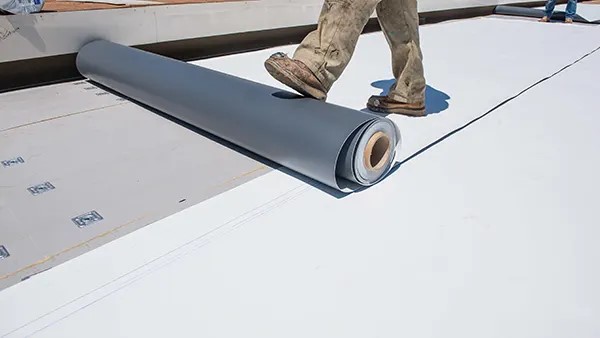
When it comes to selecting the right roofing material for your commercial property, you have several options to choose from. One popular choice today is thermoplastic olefin, otherwise known as TPO roofing. It's an excellent choice for those mindful about the environmental footprint of their building. TPO roofs offer a host of advantages, like exceptional durability, energy efficiency, and ease of installation.
What is TPO Roofing?
TPO roofing is a type of single-ply roofing membrane. It is designed from a blend of polypropylene and ethylene-propylene rubber. This blend offers the beneficial properties of both materials including flexibility, UV resistance, and durability. The material comes in a wide assortment of sheets, which can be installed by either adhering them to the roof base or mechanically fastening them. Furthermore, heat is typically applied to the seams, creating a cohesive and resistant bond. The result is a smooth, comprehensive surface that is aesthetically pleasing.
Composition of TPO Roofing
A TPO membrane consists of three main layers: a TPO polymer base, a polyester-reinforced fabric center, and the thermoplastic top ply. This combination is what gives TPO roofing its durability and scalability for use on a variety of roof sizes. The reinforcement scrim gives the TPO membrane its strength, toughness, and puncture resistance.
Benefits of TPO Roofing
The high demand for TPO roofing is mainly attributed to its considerable list of benefits that work in favor of both the environment and the property owner.
- Energy Efficient: TPO's white reflective surface surpasses the EPA's Energy Star requirements, and white, tan, and gray are listed with the Cool Roof Rating Council. This means that TPO roofing can significantly reduce your property’s cooling costs in warmer months.
- Environmentally Friendly: TPO is 100% recyclable, making it an environmentally friendly roofing option. It doesn't contain chlorine, a hazardous element found in other roofing materials.
- Resilient: TPO is resistant to algae, chemicals, and dirt accumulation. It also doesn’t require pressure washing or other types of cleaning.
- Durable: TPO’s flexibility makes it highly resistant to impact and puncture damage, as well as tears.
- Cost-Effective: TPO roofing is one of the least expensive types of commercial roofing materials, making it a cost-effective roofing solution.
Installation of TPO Roofing
The installation process of a TPO roofing system is fairly straightforward. The first step is to prepare the roof deck for installation by making sure it's clean, dry, and smooth. Next, a TPO membrane is rolled onto the roof, and then it’s secured either by using a substance known as roofing adhesive or by mechanically fastening it to the roof deck. The seams between the sheets are heat-welded together to create a single, seamless surface. This installation process does require specialty equipment and trained professionals to ensure the job is done correctly.
TPO Roofing Maintenance
Despite its durability and resistance to various elements, a TPO roofing system does require regular maintenance to ensure its longevity. This typically includes a biannual inspection to check for any signs of wear or damage. It is also recommended that you keep the roof free from debris and clear drains to prevent water buildup.
The Outlook for TPO Roofing
The future looks bright for TPO roofing. As more organizations aim to reduce their ecological footprint and save on energy costs, the demand for energy-efficient, eco-friendly roofing systems is likely to increase. And considering the many advantages of TPO roofing, it stands prominently as an attractive option for businesses large and small.
To conclude, when looking for a roofing option that is cost-effective, durable, and environmentally-friendly, TPO roofing is certainly worth considering. It may be just the roofing solution your commercial property needs.
Frequently Asked Questions about TPO Roofing
How does TPO roofing compare to other types of roofing?
TPO roofing offers a balanced combination of performance, cost-effectiveness, and energy efficiency, which makes it a popular choice compared to EPDM, PVC, and other types of roofing. Its reflective surface helps minimize heat gain, reducing energy costs.
Does TPO roofing stand up to harsh weather conditions?
TPO roofs are built to withstand a variety of weather conditions. The material is flexible and hence, can handle building movement and settling without compromising its protective features. However, it's always advised to keep the roof clear of debris and regularly inspect for damage after significant weather events.
How long does TPO roofing last?
The lifespan of a TPO roof can vary based on factors like the quality of installation, the product's thickness, and how well it's maintained. Generally, a TPO roof can last between 15-20 years when properly taken care of.
Is TPO roofing eco-friendly?
Yes, TPO roofing is considered an eco-friendly option for several reasons. The material reflects sunlight, which can reduce energy use and costs, and certain TPO roofs are 100% recyclable at the end of their life, reducing the contribution to landfill waste.
What’s involved in the installation of TPO roofing?
TPO roofing installation generally involves several stages. First, the existing roof must be prepared or, in some cases, completely removed. Then, the TPO membrane is laid out and secured. Depending on the specifics of the building, the TPO roofing might be mechanically attached, ballasted, or fully adhered to the roof surface.
Can TPO roofing be installed over an existing roof?
In many cases, TPO roofing can be laid over an existing roof, which can save on costs associated with roof tear-off and disposal. However, this often depends on the condition and type of the existing roof, local building codes, and the specific TPO product being used.
Is TPO roofing easy to repair?
Repairs to TPO roofing can often be made relatively easily, especially in the case of small punctures or seam separations. Repairs involve cleaning the area, applying a primer, and then using a TPO repair tape or adhesive to seal the problem area. However, larger or more complex issues may require professional assessment and repair.
How can I maintain my TPO roof?
TPO roof maintenance generally involves regular inspections (ideally twice a year, and after any significant weather events), keeping the roof clear of debris, and promptly addressing any small repairs that may be necessary. It's also important to avoid allowing heavy equipment or excessive foot traffic on the roof whenever possible.
Will TPO roofing discolor or fade over time?
The color stability of TPO roofing can vary based on the specific product and the environment in which it’s installed. High-quality TPO roofs are generally formulated to resist discoloration and maintain their reflectivity over time.
How does TPO roofing help with energy efficiency?
TPO’s natural reflective surface can reduce the amount of heat a building absorbs, especially in warmer climates. This can translate to a lower need for air conditioning and less energy used for cooling, potentially reducing energy costs significantly.
Pros and Cons of TPO Roofing
Pros of TPO Roofing
Cost-Effective
TPO roofing is a relatively inexpensive roofing material compared to its alternatives. It offers premium-quality roofing at a lower cost, making it a preferred choice for many property owners when considering the initial investment.
- Affordable compared to EPDM or PVC
- Low up-front costs
Energy Efficiency
TPO roofing is known for its superb thermal resistance and energy efficiency. The light-colored surface of a TPO roof reflects sunlight instead of absorbing it, helping to maintain a cooler building during the summer months. This can result in significant energy savings by reducing the need to use air conditioning.
- Highly reflective to UV rays
- Energy Star rated
Flexibility and Versatility
This roofing material has the ability to adapt and change with different building movements and settings, reducing the chances of cracking or breaking over time. Moreover, TPO is available in different colors, allowing building owners to match their aesthetic preferences without compromising the energy-saving benefits.
- Can handle building movement well
- More color choices compared to other single-ply membranes
Easy Installation
The lightweight material and wide sheets of TPO roofing make it faster and easier to install compared to other roofing materials. Consequently, the installation costs of TPO roofing are often lower.
- Simpler process, typically leading to lower installation costs
- The lightweight material allows less stress on the building's structure
Cons of TPO Roofing
Short Lifespan
In comparison to other single-ply membranes, TPO roofing has a shorter lifespan. As a relatively new product in the roofing market, the longest a TPO roof has existed to this date is around 30 years.
- Often lasts between 15-20 years
- Lower lifespan compared to PVC and EPDM
Lack of Consistency in Manufacturing
Since TPO is a relatively new product in the roofing industry, the manufacturing processes are not as standardized as they are for older and more traditional roofing materials. Variations are often observed between different brands, which may affect the roofing's quality and performance.
- Quality can vary greatly between manufacturers
- Less reliable long-term performance data
Prone to Seam Failures
The seams of TPO roofing are heat-welded together. Although this is a strong point of connection when newly installed, as the roofing ages and is subjected to constant temperature fluctuations, the seams can fail, leading to leaks.
- Seams may weaken over time
- Risks of water leaks are higher due to eventual seam failures
Need for Professional Installation
Though TPO roofing's installation process is relatively simple, it still requires professional handling for optimum function. The heat-welding process of seams must be performed correctly, or the integrity of the roofing system could be compromised.
- May not be suitable for DIY installation
- Improper installation may decrease the potential life expectancy of the roof
Summary
The durability of TPO roofing makes it a convenient choice for commercial buildings. It's resistant to dirt, bacteria, algae, and debris build-up meaning it requires less maintenance compared to other roofing types. The ability to withstand UV radiation and extreme weather conditions has made TPO roofing a top consideration for building owners looking to maximize their return on investment.
Investing in TPO roofing does not only make economic sense in the long run but also contributes to the green initiative. It reflects sunlight reducing the cooling load and saving energy, which directly translates to cost savings on utility bills. Further, the fact that TPO roofing is recyclable at the end of its life span is a plus for the environmentally conscious individuals and companies.
In the spectrum of commercial roofing solutions, TPO roofing stands out with its unique benefits and functionalities. Its cool roofing ability, energy efficiency, and durability make it stand out. With proper installation and maintenance, owners can rest assured of a sustainable and cost-effective roofing choice in TPO roofing.
About Top Tier Roofing
Meet Top Tier Roofing, your go-to roofing solution in Jefferson, GA. We're a local company committed to delivering superior roofing services that exceed your expectations. Our team of dedicated professionals, armed with cutting-edge tools and vast expertise, work tirelessly to ensure that every roof we handle is a testament to quality and durability. Whether you require a quick repair or a total roof replacement, our adept team will get the job done right the first time. Partnering with us means ensuring the safety and longevity of your roofing system. Let Top Tier Roofing transform and secure your homes and buildings, topped off with a stellar customer service experience.
Subscribe to Top Tier Roofing & Restoration's Blog





Comments